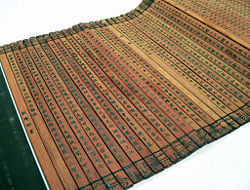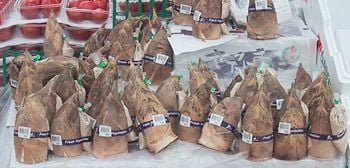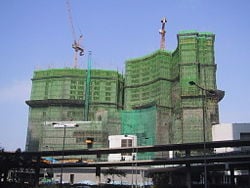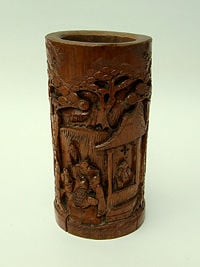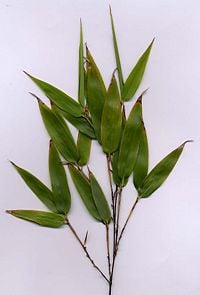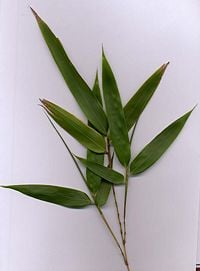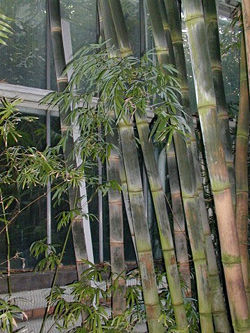Difference between revisions of "Bamboo" - New World Encyclopedia
Kuna Hamad (talk | contribs) |
Rosie Tanabe (talk | contribs) |
||
| (40 intermediate revisions by 8 users not shown) | |||
| Line 1: | Line 1: | ||
| − | {{ | + | {{Ebcompleted}}{{Approved}}{{Images OK}}{{Submitted}}{{Paid}}{{copyedited}}{{2Copyedited}} |
{{Taxobox | {{Taxobox | ||
| color = lightgreen | | color = lightgreen | ||
| − | | name = | + | | name = Bamboo |
| image = BambooKyoto.jpg | | image = BambooKyoto.jpg | ||
| image_width = 240px | | image_width = 240px | ||
| − | | image_caption = Bamboo forest in | + | | image_caption = Bamboo forest in Kyoto, [[Japan]] |
| regnum = [[Plant]]ae | | regnum = [[Plant]]ae | ||
| divisio = [[flowering plant|Magnoliophyta]] | | divisio = [[flowering plant|Magnoliophyta]] | ||
| Line 15: | Line 15: | ||
| tribus = '''Bambuseae''' | | tribus = '''Bambuseae''' | ||
| tribus_authority = [[Carl Sigismund Kunth|Kunth]] ex [[Barthélemy Charles Joseph Dumortier|Dumort.]] | | tribus_authority = [[Carl Sigismund Kunth|Kunth]] ex [[Barthélemy Charles Joseph Dumortier|Dumort.]] | ||
| − | | diversity = Around 91 [[genus|genera]] and 1, | + | | diversity = Around 91 [[genus|genera]] and 1,200 [[species]] |
| − | | diversity_link = Taxonomy of | + | | diversity_link = #Taxonomy of Bambuseae |
| subdivision_ranks = [[Subtribe]]s | | subdivision_ranks = [[Subtribe]]s | ||
| subdivision = | | subdivision = | ||
| Line 28: | Line 28: | ||
*[[Racemobambodinae]] | *[[Racemobambodinae]] | ||
*[[Shibataeinae]] | *[[Shibataeinae]] | ||
| − | See the full '''[[Taxonomy of the Bambuseae]]''' | + | See the full '''[[#Taxonomy of Bambuseae|Taxonomy of the Bambuseae]].''' |
}} | }} | ||
| − | ''' | + | '''Bamboo''' comprises more than 1200 species of usually [[wood]]y, [[perennial plant|perennial]] [[plant]]s in the true grass family '''[[Poaceae]],''' occurring primarily in tropical, subtropical, and temperate regions in Asia, Africa, and the Americas. Bamboo are distributed among more than 90 genera in the subfamily [[Bambusoideae]] and the tribe '''Bambuseae.''' The term also is used for the woody stems of these grasses, which have commercial value. |
| − | + | Unlike most [[grass]]es, bamboos can grow very tall, with some members reaching heights of up to 30 meters (98 feet). | |
| − | + | In addition to its value to the [[ecosystem]], providing food for [[giant panda]]s, [[insect]] [[larva]]e, gorillas, and elephants, bamboo is valued by humans for its culinary, medicinal, construction, artistic, and ornamental uses. The shoots of bamboo are used in numerous Asian dishes and broths; pickled bamboo is used as a condiment; and the sap of young stalks may be fermented to make a sweet wine or used to make a soft drink. Bamboo is used in Chinese medicine for treating infections and as a low calorie source of [[potassium]]. When properly processed and treated, bamboo forms a very hard, tough, and yet lightweight wood, useful in house construction, as well as for fences, bridges, furniture, and numerous other purposes, including the making of various musical instruments. The practice of carving bamboo for decorative artwork is widespread, and in [[China]] the fiber of bamboo has been used since early times for making [[paper]]. Bamboo is also popular as an ornamental plant. | |
| − | + | Bamboo assumes symbolic meaning in East Asian culture, signifying such values as longevity and friendship, as representing the four seasons or a sacred barrier against evil. Bamboo represents eternity, tradition, and lineage, as noted in the [[Vietnam]]ese proverb, "When the bamboo is old, the bamboo sprouts appear." | |
| − | |||
| − | [[ | ||
| − | + | ==Description== | |
| − | In [[Indonesia]] | + | Bamboo is a member of the grass family, Poaceae, which is one of the largest [[plant]] families, and to humans perhaps the most important, as this family includes agricultural grains such as wheat and rice, as well as sugar cane. The Poaceae comprise about 600 genera and perhaps ten thousand species of grasses, which include among them bamboo's more than 90 genera and more than 1200 species. |
| + | |||
| + | The tall species of bamboo are by far the largest members of the grass family, with the younger tips of some of those species growing more than 1 meter per day toward their ultimate height of more than 30 meters. As with all bamboo, the growth to maximum height and width is completed within one growing season. In subsequent years, the wood will harden and sprout more branchlets and leaves from the nodes in the stem, often starting at some distance up the [[culm]] (stalk) from the ground level. | ||
| + | |||
| + | Most bamboos are [[tree#evergreen versus deciduous|evergreen]], but some have deciduous leaves. | ||
| + | |||
| + | The range encompassed by the many bamboo species extends from high mountains to low-lying [[tropical]] regions. Bamboo occur across [[East Asia]], from 50°N latitude on [[Sakhalin]] Island in the Sea of Okhotsk, west to the [[Himalaya]]s and [[Pakistan]], and south as far as northern Australia.<ref>Bystriakova et al. 2003.</ref>. They also occur in sub-[[Sahara]]n [[Africa]], and in the [[The Americas|Americas]], where their range extends from the southeast of the [[United States|U.S.]] to their most southerly limit at 47°S latitude in [[Chile]].<ref>USDA 2007.</ref> Major areas with no native bamboos include [[Europe]], north Africa, western [[Asia]], [[Canada]], most of [[Australia]], and [[Antarctica]]. | ||
| + | |||
| + | Many bamboos grow as an understory in a forest whose canopy is formed by deciduous or coniferous trees (or both). The forests frequented by the [[giant panda]] in [[China]], for example, are old growth forests with a canopy of both [[deciduous trees|deciduous]] and [[coniferous trees]], and an understory of bamboos, whose shallow root systems tend to occupy different soil terrain than the deep roots of the canopy trees. | ||
| + | |||
| + | Soft bamboo shoots, stems, and leaves are the major food source of the giant panda. [[Gorilla]]s and [[elephant]]s in parts of Africa forage on bamboo shoots when they are in season. Other animals that depend on the bamboo forests include the clouded leopard ranging from [[Nepal]] to southeastern China, the red panda on the forested slopes of the [[Himalaya Mountains]], the ring-tailed lemur of [[Madagascar]], [[cassawary|cassowaries]] (large, flightless birds) found in Northeast [[Australia]] and [[New Guinea]], and rhinoceros hornbill birds of [[Malaysia]], [[Borneo]], [[Sumatra]], and [[Java]]. | ||
| + | |||
| + | ==Traditional uses== | ||
| + | |||
| + | A western person who observed the many uses made of bamboo more than 100 years ago in China has recorded for posterity a glimpse of just how remarkably versatile bamboo is: | ||
| + | [[Image:Bamboo book - unfolded - UCR.jpg|thumb|250px|right|A [[China|Chinese]] bamboo [[book]], unfolded.]] | ||
| + | |||
| + | "Ode to Bamboo" | ||
| + | |||
| + | <blockquote>A man can sit in a bamboo house under a bamboo roof, on a bamboo chair at a bamboo table, with a bamboo hat on his head and bamboo sandals on his feet. He can at the same time hold in one hand a bamboo bowl, in the other hand bamboo chopsticks and eat bamboo sprouts. When through with his meal, which has been cooked over a bamboo fire, the table may be washed with a bamboo cloth, and he can fan himself with a bamboo fan, take a siesta on a bamboo bed, lying on a bamboo mat with his head resting on a bamboo pillow. His child might be lying in a bamboo cradle, playing with a bamboo toy. On rising he would smoke a bamboo pipe and taking a bamboo pen, write on bamboo paper, or carry his articles in bamboo baskets suspended from a bamboo pole, with a bamboo umbrella over his head. He might then take a walk over a bamboo suspension bridge, drink water from a bamboo ladle, and scrape himself with a bamboo scraper (handkerchief).<ref>William Edgar Geil, ''A Yankee on the Yangtze'' (London: A.C. Armstrong and Son. 1904). Page 268.</ref> | ||
| + | </blockquote> | ||
| + | ===Cuisine=== | ||
| + | [[Image:TakenokoBambooSprouts.jpg|right|thumb|350px|left|Edible bamboo shoots.]] | ||
| + | |||
| + | The shoots of bamboo, new culms as they first emerge from the soil, are called in [[Chinese language|Chinese]], ''zhú sǔn'' (simplified: 竹笋; traditional: 竹筍) or simply ''sǔn'' (笋). These are edible, used in numerous Asian dishes and broths, and are available in supermarkets in various sliced forms, either fresh or canned. Bamboo shoot tips are called ''zhú sǔn jiān'' (竹笋尖) or simply ''sǔn jiān'' (笋尖). | ||
| + | |||
| + | In [[Indonesia]], the shoots are sliced thinly and then boiled with ''santan'' (thick [[coconut]] milk) and spices to make a dish named ''gulai rebung.'' Other recipes using bamboo shoots include ''sayur lodeh,'' a vegetable dish mixed in coconut milk, and ''lun pia'' (sometimes written ''lumpia''), which is fried, wrapped bamboo shoots with vegetables. Note that the shoots of some species contain toxins that need to be leached or boiled out before they can be eaten safely. | ||
Pickled bamboo, used as a condiment, may also be made from the pith of the young shoots. | Pickled bamboo, used as a condiment, may also be made from the pith of the young shoots. | ||
| − | The sap of young stalks tapped during the rainy season may be fermented to make a sweet wine, ''ulanzi'' | + | The sap of young stalks tapped during the rainy season may be fermented to make a sweet wine, ''ulanzi,'' or simply made into a soft drink. ''Zhúyèqīng jiǔ'' (竹葉青酒) is a green-colored Baijiu Chinese liquor that has bamboo leaves as one of its ingredients. |
| − | Bamboo leaves are | + | Bamboo leaves also are used as wrappers for ''zongzi,'' a steamed dumpling typical of southern [[China]] that usually contains glutinous [[rice]] and other ingredients. |
| − | The empty hollow in the stalks of larger bamboo is | + | The empty hollow in the stalks of larger bamboo is used for cooking food in many Asian cultures. Soups are boiled and rice is cooked in the hollows of fresh stalks of bamboo directly over a flame. As well, steamed tea is sometimes rammed into bamboo hollows to produce compressed forms of Pu-erh tea. |
| − | + | In Sambalpur, [[India]], the tender shoots are grated into julliens and fermented to prepare ''kardi.'' Also synonymous with bamboo shoots, the name is derived from the Sanskrit word for bamboo shoot, ''karira.'' This fermented bamboo shoot is used in various culinary preparations, notably ''amil,'' a sour vegetable soup. It is also made into pancakes using rice flour as a binding agent, along with spices and condiments to prepare a side dish in the local main meal. The shoots that have turned a little fibrous are fermented, dried, and ground to sand-size particles to prepare a garnish known as ''hendua.'' | |
| − | + | Bamboo has gained increasing popularity in the culinary world as a material for cutting boards, as bamboo cutting boards are hard enough to withstand years of knife abuse, yet are more forgiving to the knife blade and cause less damage to the edged utensils over time than cutting boards made of other materials. | |
| − | === | + | ===Medicine=== |
| − | Bamboo is used in Chinese medicine for treating infections. It is also a low calorie source of potassium. | + | Bamboo is used in Chinese medicine for treating infections. It is also a low calorie source of [[potassium]]. In Ayurveda, the Indian system of medicine, the siliceous concretion found in the culms of the bamboo is called ''banslochan.'' It is known as ''tabashir'' or ''tawashir'' in ''Unani-Tibb,'' the Indo-Persian system of medicine. This concretion, called in English, "bamboo manna," is said to be a tonic for respiratory diseases. This concretion, which was earlier obtained from the species ''Melocanna bambusoides,'' is very hard to get now and has been largely replaced by synthetic silicic acid. In most Indian literature, ''Bambusa arundinacea'' has been shown to be the source of bamboo manna.<ref>Puri 2003.</ref> |
| − | === | + | ===Construction=== |
| − | [[Image:BambooConstructionHongKong.jpg|thumb| | + | [[Image:BambooConstructionHongKong.jpg|thumb|250px|right|Bamboo [[scaffolding]] can reach great heights.]]When treated, bamboo forms a very hard wood that is both light and exceptionally tough. In tropical climates, it is used in elements of house construction, as well as for fences, bridges, toilets, construction scaffolding, and as a substitute for steel reinforcing rods in [[concrete]] construction. When bamboo is harvested for wood, care is needed to select mature stems that are several years old, as first-year stems, although full size, are not fully woody and strengthened. |
| − | |||
| − | When treated, bamboo forms a very hard wood | ||
===Artwork=== | ===Artwork=== | ||
| − | + | [[Image:Chinese bamboo carving1.jpg|thumb|left|200px|[[China|Chinese]] bamboo carving, late [[Qing Dynasty]].]]Carving decorative bamboo artwork is a longstanding tradition in many cultures. The fiber of bamboo has been used for making [[paper]] in China since early times, and a high quality hand-made paper is still produced in small quantities. Coarse bamboo paper is still used to make Joss paper, or "spirit money," which is burned in traditional Chinese funerals and in ceremonies to deities or ancestors on traditional holidays. | |
| − | + | Bamboo wood is used for making [[knitting]] needles, and bamboo fiber can be made into yarn and fabrics. Bamboo fabric is notable for its soft feel and natural antibacterial properties.<ref>Lela Designs, 2007.</ref> Clothing made from bamboo fiber is popular for activities such as [[yoga]]. Bed sheets and towels made from bamboo have become luxury items. Sharpened bamboo is also traditionally used for tattooing in Japan, Hawaii, and elsewhere. | |
| − | + | ===Accessories=== | |
| − | + | Bamboo canes are normally round in cross-section, but square canes can be produced by forcing the new, young culms to grow through a tube of square cross-section slightly smaller than the culm's natural diameter, thereby constricting the growth to the shape of the tube. Every few days the tube is removed and replaced higher up the fast-growing culm. | |
| − | |||
| − | + | Bamboo also is used as a shank extension on smoking pipes. Often a bamboo shank is added as a repair when a shank is cracked with use, or to repair a flaw during manufacture. | |
| − | + | A variety of bamboo was one of about two dozen plants carried by [[Polynesia]]n voyagers to provide all their needs when settling new islands. In the [[Hawaiian Islands]], among many uses, 'Ohe (bamboo) carried water, made irrigation troughs for taro terraces, was used as a traditional knife for cutting the [[umbilical cord]] of a newborn, as a stamp for dyeing bark tapa cloth, and for four hula instruments—nose flute, rattle, stamping pipes, and Jew's harp. | |
| − | + | ===Recreation=== | |
| + | [[Image:Bamboobike.jpg|thumb|250px|[[Bicycle]] frame made of bamboo (1896)]] | ||
| + | Some skateboard and snowboard deck manufacturers, as well as surfboard builders, are beginning to use bamboo construction because bamboo can be both lighter and stronger than traditional materials and its cultivation is environmentally friendly. | ||
| − | + | Bamboo is used also for making enclosures in fish farming, where cages can be made from a wooden frame and bamboo lattices. Bamboo is also used in the making of the high-end, lightweight fishing rods used in [[fly fishing]]. | |
| − | === | + | ===Musical instruments=== |
| − | [[ | + | |
| − | + | Bamboo is used in making various musical instruments, such as the [[dizi]], [[Xiao (flute)|xiao]], [[shakuhachi]], [[palendag]], [[jinghu]], and angklung. The Bamboo Organ of Las Pinas, [[Philippines]], has pipes made of bamboo culms. | |
| − | + | In [[Indonesia]], bamboo has been used for making various kinds of musical instruments, the most popular ones being kolintang and angklung. Especially for angklung, it is the pride and joy of the [[Sundanese]] people, and they have been safeguarding this tradition for centuries. Although, it is (to a lesser extent) also played by the Balinese, and later on spread to the neighboring countries in south east Asia. | |
| − | + | A single shoot of bamboo can also be made into a [[didgeridoo]], a wind instrument indigenous to [[Australia]]. | |
| − | |||
| − | + | ==Cultivation== | |
| − | + | [[Image:Phyllostachys nigra folium.jpg|right|thumb|200px|Bamboo foliage with black stems (probably ''Phyllostachys nigra'')]] | |
| − | [[Image:Bamboo-yellow.jpg| | + | [[Image:Bamboo-yellow.jpg|right|thumb|200px|Bamboo foliage with yellow stems (probably ''Phyllostachys aurea'')]]Many bamboos are popular in cultivation as [[garden]] plants, although care needs to be taken lest they take over the garden through their [[invasive species|invasive]] behavior. They spread mainly through their [[root]]s and/or [[rhizomes]], which can spread widely underground and send off new culms to break through the surface. |
| + | There are two patterns for the spreading of bamboo, "clumping" (sympodial), and "running" (monopodial). Clumping bamboo species tend to spread underground slowly. Bamboos are highly variable in their tendency to spread; this is related to both the species and the [[soil]] and [[climate]] conditions. Some can send out runners several meters in a year, while others can stay in the same general area for long periods. | ||
| − | + | Once a grove of bamboo is established, it may not be possible to completely remove it without digging up the entire network of underground rhizomes. If bamboo must be removed, an alternative to digging it up is to cut down the culms, and then repeatedly mow down new shoots as they arise, until the root system exhausts its energy supply and dies. If any [[leaf|leaves]] are allowed to [[photosynthesis|photosynthesize]], the bamboo survives and will keep spreading. | |
| − | + | There are two main ways to prevent the spread of running bamboo into adjacent areas. The first method is rhizome pruning or "edging," which involves removing any rhizomes escaping the desired bamboo area. Hooks, shovels, and picks are usual tools. The rhizomes are generally very close to the surface (just under a sod layer), so, if rhizome pruning is done twice a year, it will sever most, if not all, of the new growth. Some species may be deep running (beyond typical spade depth). These are much harder to control and deeper cuts will need to be made. Regular maintenance will indicate major growth directions and locations. Once the rhizomes are cut, they should be removed. If any bamboo shoots come up outside of the bamboo area afterwards, their presence indicates the precise location of the missed rhizome. The fibrous roots that radiate from the rhizomes do not grow up to be more bamboo, so they stay in the ground. | |
| − | |||
| − | There are two main ways to prevent the spread of running bamboo into adjacent areas. The first method is rhizome pruning or "edging" | ||
| − | The second way is by surrounding | + | The second way is by surrounding the bamboo root mass with a physical barrier. Concrete and specially rolled HDPE plastic are usual materials. This is placed in a 60-90 cm (2-3 feet) deep ditch around the planting, and angled out at the top to direct the rhizomes to the surface. Strong rhizomes and tools can penetrate plastic barriers with relative ease, so great care must be taken. Bamboo entangled in barriers is much more difficult to remove than free-spreading bamboo. Barriers and edging are unnecessary for clump forming bamboos, although even they may eventually need to have portions taken out if they get too large. |
==Bamboo in human culture== | ==Bamboo in human culture== | ||
| − | |||
===Symbolism=== | ===Symbolism=== | ||
| − | In Chinese culture, the bamboo (''zhú'' 竹), [[plum]] blossom (''méi'' 梅), [[orchid]] (''lán'' 蘭), and chrysanthemum (''jú'' 菊) (usually, ''méi lán zhú jú'' 梅蘭竹菊) are collectively referred to as the Four Noble Ones (四君子). These four plants also represent the four [[season]]s and, in [[Confucius|Confucian]] ideology, four aspects of the junzi (君子 "prince" or "noble one"). The [[pine]] tree (松), the bamboo, and the plum blossom (''sōng zhú méi'' 松竹梅) are also admired for their perseverance under harsh conditions, and are together known as the "Three Friends in Winter" (歲寒三友). | + | [[Image:Hsü Wei 001.jpg|thumb|left|300px|Bamboo, by [[Xu Wei]] in [[Ming Dynasty]].]]In Chinese culture, the bamboo (''zhú'' 竹), [[plum]] blossom (''méi'' 梅), [[orchid]] (''lán'' 蘭), and chrysanthemum (''jú'' 菊) (usually, ''méi lán zhú jú'' 梅蘭竹菊) are collectively referred to as the [[Four Noble Ones]] (四君子). These four plants also represent the four [[season]]s and, in [[Confucius|Confucian]] ideology, four aspects of the junzi (君子 "prince" or "noble one"). The [[pine]] tree (松), the bamboo, and the plum blossom (''sōng zhú méi'' 松竹梅) are also admired for their perseverance under harsh conditions, and are together known as the "Three Friends in Winter" (歲寒三友). |
| − | Bamboo's long life makes it a Chinese symbol of longevity, while in [[India]] it | + | Bamboo's long life makes it a Chinese symbol of longevity, while in [[India]] it remains a symbol of friendship. The rarity of its [[bamboo blossom|blossoming]] has led to the [[flower]]s' being regarded as a sign of impending famine. This may be due to [[rat]]s feeding upon the profusion of flowers, then multiplying and destroying a large part of the local food supply. The most recent flowering began in May 2006. Bamboo is said to bloom in this manner only about every 50 years.<ref>Huberman 1959.</ref> |
| − | In [[Japan]], a bamboo forest sometimes surrounds a Shinto shrine as part of a sacred barrier against [[evil]]. Also, bamboo (''také'' 竹) indicates something of the second rank, | + | In [[Japan]], a bamboo forest sometimes surrounds a Shinto shrine as part of a sacred barrier against [[evil]]. Also, bamboo (''také'' 竹) indicates something of the second rank, as a [[sushi]] set or accommodations at a traditional Ryokan inn. This comes from the Chinese phrase 松竹梅 (in Japanese, ''sho-chiku-bai''), where [[pine]] (''matsu'' 松) is of the first rank, and plum (''ume'' 梅) is of the third. |
| − | A [[Vietnam]]ese proverb says: "When the bamboo is old, the bamboo sprouts appear" | + | A [[Vietnam]]ese proverb says: "When the bamboo is old, the bamboo sprouts appear," the meaning being Vietnam will never be annihilated; if the previous generation dies, the children takes its place. Therefore the Vietnamese tradition will be maintained and developed eternally. |
===Myths and legends=== | ===Myths and legends=== | ||
[[Image:Bamboo bonsai Chengdu.jpg|thumb|400px|Bamboo [[bonsai]]]] | [[Image:Bamboo bonsai Chengdu.jpg|thumb|400px|Bamboo [[bonsai]]]] | ||
| − | Several Asian cultures, including that of the [[Andaman Islands]], believe that humanity emerged from a bamboo stem. In the [[Philippines|Philippine]] creation myth, | + | Several Asian cultures, including that of the [[Andaman Islands]], believe that humanity emerged from a bamboo stem. In the [[Philippines|Philippine]] creation myth, the first man and the first woman came forth from a special bamboo stem that grew on an island created after the battle of the elemental forces (Sky and Ocean). In [[Malaysia]]n legends, a similar story includes a man who dreams of a beautiful woman while sleeping under a bamboo plant; he wakes up and breaks the bamboo stem, discovering the woman inside. The Japanese folktale "Tale of the Bamboo Cutter" ''(Taketori Monogatari)'', tells of a princess from the Moon emerging from a shining bamboo section. [[Hawaiian Islands|Hawaiian]] bamboo ('ohe) is a kinolau, or body form of the Polynesian creator god Kāne Milohai. |
| + | |||
| + | An ancient [[Vietnam]]ese legend tells of a poor, young farmer who fell in love with his landlord's beautiful daughter. The farmer asked the landlord for his daughter's hand in marriage, but the proud landlord would not allow her to be bound in marriage to a poor farmer. The landlord decided to foil the marriage with an impossible deal; the farmer must bring him a "bamboo tree of one-hundred sections." The benevolent god [[Bụt]] appeared to the farmer and told him that such a tree could be made from one-hundred sections from several different trees. Bụt gave to him four magic words to attach the many sections of bamboo: "Khắc nhập, khắc xuất," which means "put in immediately, take out immediately." The triumphant farmer returned to the landlord and demanded his daughter. The story ends with the happy marriage of the farmer and the landlord's daughter. | ||
| + | |||
| + | ===Science=== | ||
| + | The [[Song Dynasty]] (960-1279 C.E.) Chinese scientist and polymath, Shen Kuo (1031-1095), used the evidence of underground petrified bamboo found in the dry northern climate of Yan'an, Shanbei region, Shaanxi province to support his [[geological]] theory of gradual [[climate change]].<ref>ICHSEA 2003; Needham 1986.</ref> | ||
| + | ==Innovative uses== | ||
| − | + | With perhaps a billion people in the developing world dependent on bamboo in one way or another, bamboo has often in the twentieth century been associated with poverty. That old image is being displaced in the twenty-first century by the new image of a versatile plant offering essential survival values for even the most advanced countries, as all are increasingly forced to grapple with the issue of environmental sustainability. Here, bamboo is in a class by itself. | |
| − | + | Bamboo offers unique economic and ecological values as a commercially grown source of wood products adaptable to a multitude of construction uses and competitive with conventional hardwood and softwood construction materials in terms of price and performance. As a woody, perennial grass, bamboo offers strong environmental values that cannot be matched by hardwood and softwood products because bamboo can be harvested as a mature plant on a cycle varying from 3-7 years, while leaving in the ground the root system that can grow a new crop over another 3-7 years. The dense root system holds the soil in place even after the crop is harvested and the relatively light weight of a mature bamboo stalk in comparison to timber means that the bamboo harvesting equipment can be less disruptive of the ground surface than timber harvesting equipment. | |
| − | The [[ | + | |
| + | The South American country of Colombia became a global-level center of innovation of bamboo construction after the 2000 World Expo in Hannover, Germany, where the most-visited pavilion was a large bamboo structure designed and fabricated in Colombia. Several German academic institutions collaborated in testing the pavilion's construction quality and in the end certified it as being fully safe and sound. The pavilion received more than 6 million visitors during the 5 month Expo. It was subsequently disassembled and then reassembled and permanently mounted back in Manizales, Colombia, in the heart of the country's coffee growing area, which was the area responsible for originally funding the building as part of a larger effort toward sustainability inspired by the Zero Emissions Research and Initiatives (ZERI). The architect, [[Simon Velez]], has become a leader in a global movement to establish bamboo as primary construction material throughout the world. People have gone to Colombia to study with him then take their new knowledge and expertise in building with bamboo back to their home country. | ||
| + | |||
| + | Modern companies are attempting to popularize bamboo flooring made of bamboo pieces steamed, flattened, glued together, finished, and cut, and the effort is succeeding in the U.S. and Europe. National and state level bamboo associations are proliferating and affiliating under the umbrella of the [[World Bamboo Organization]], which declares its mission to be that of promoting and supporting the use of bamboo as a sustainable and alternative natural resource. Interests of the organization's members range from growing bamboo in gardens to growing it as a commercial product, processing it into an effective construction material, building bamboo homes and buildings, and as well living in a bamboo house. The first decade of the twenty-first century has been a period for bamboo to pass through all the tests for gaining international building code certification for use in the manufacture of such products as chipboard, plywood, I-Beams, and other bamboo structural materials. A factory in Vietnam was the first to gain international building code certification for its full range of building products, while the first company in the U.S. offering building code approved bamboo homes was based in Hawaii. | ||
| + | |||
| + | ==Taxonomy of Bambuseae== | ||
| + | The Bambuseae comprises around 1,200 [[species]], distributed into numerous [[Tribe (biology)|tribes]], [[subtribe]]s, and about 91 [[genus|genera]]: | ||
| + | |||
| + | [[Image:Bambusa-vulgaris.web.jpg|thumb|right|250px|''Dendrocalamus'' spp.]] | ||
| + | |||
| + | ===Subtribe [[Arthrostylidiinae]]=== | ||
| + | It comprises 12 genera: | ||
| + | *''[[Actinocladum]]'' | ||
| + | *''[[Alvimia]]'' | ||
| + | *''[[Arthrostylidium]]'' | ||
| + | *''[[Athroostachys]]'' | ||
| + | *''[[Atractantha]]'' | ||
| + | *''[[Aulonemia]]'' ''(Matudacalamus)'' | ||
| + | *''[[Colanthelia]]'' | ||
| + | *''[[Elytrostachys]]'' | ||
| + | *''[[Glaziophyton]]'' | ||
| + | *''[[Merostachys]]'' | ||
| + | *''[[Myriocladus]]'' | ||
| + | *''[[Rhipidocladum]]'' | ||
| + | |||
| + | ===Subtribe [[Arundinariinae]]=== | ||
| + | It comprises 17 genera: | ||
| + | *''[[Acidosasa]]'' | ||
| + | *''[[Ampelocalamus]]'' | ||
| + | *''[[Arundinaria]]'' | ||
| + | *''[[Borinda]]'' | ||
| + | *''[[Chimonocalamus]]'' ''(Sinarundinaria)'' | ||
| + | *''[[Drepanostachyum]]'' | ||
| + | *''[[Fargesia]]'' | ||
| + | *''[[Ferrocalamus]]'' | ||
| + | *''[[Gaoligongshania]]'' | ||
| + | *''[[Gelidocalamus]]'' | ||
| + | *''[[Himalayacalamus]]'' | ||
| + | *''[[Indocalamus]]'' | ||
| + | *''[[Oligostachyum]]'' | ||
| + | *''[[Pseudosasa]]'' | ||
| + | *''[[Sasa]]'' | ||
| + | *''[[Thamnocalamus]]'' | ||
| + | *''[[Yushania]]'' | ||
| − | == | + | ===Subtribe [[Bambusinae]]=== |
| + | It comprises 10 genera: | ||
| + | *''[[Bambusa]]'' ''(Dendrocalamopsis)'' | ||
| + | *''[[Bonia]]'' ''(Monocladus)'' | ||
| + | *''[[Dendrocalamus]]'' (''Klemachloa'', ''Oreobambos'', ''Oxynanthera'', ''Sinocalamus'') | ||
| + | *''[[Gigantochloa]]'' | ||
| + | *''[[Dinochloa]]'' | ||
| + | *''[[Holttumochloa]]'' | ||
| + | *''[[Kinabaluchloa]]'' (''Maclurochloa'', ''Soejatmia'') | ||
| + | *''[[Melocalamus]]'' | ||
| + | *''[[Sphaerobambos]]'' | ||
| + | *''[[Thyrsostachys]]'' | ||
| − | * | + | ===Subtribe [[Chusqueinae]]=== |
| + | It comprises 2 genera: | ||
| + | *''[[Chusquea]]'' (''Dendragrostis'', ''Rettbergia'') | ||
| + | *''[[Neurolepis]]'' ''(Planotia)'' | ||
| − | * | + | ===Subtribe [[Guaduinae]]=== |
| + | It comprises 5 recognized genera: | ||
| + | *''[[Apoclada]]'' | ||
| + | *''[[Eremocaulon]]'' ''(Criciuma)'' | ||
| + | *''[[Guadua]]'' | ||
| + | *''[[Olmeca]]'' | ||
| + | *''[[Otatea]]'' | ||
| − | * | + | ===Subtribe [[Melocanninae]]=== |
| + | It comprises 9 genera: | ||
| + | *''[[Cephalostachyum]]'' | ||
| + | *''[[Davidsea]]'' | ||
| + | *''[[Leptocanna]]'' | ||
| + | *''[[Melocanna]]'' ''(Beesha)'' | ||
| + | *''[[Neohouzeaua]]'' | ||
| + | *''[[Ochlandra]]'' | ||
| + | *''[[Pseudostachyum]]'' | ||
| + | *''[[Schizostachyum]]'' | ||
| + | *''[[Teinostachyum]]'' | ||
| − | * | + | ===Subtribe [[Nastinae]]=== |
| + | It comprises 6 genera: | ||
| + | *''[[Decaryochloa]]'' | ||
| + | *''[[Greslania]]'' | ||
| + | *''[[Hickelia]]'' | ||
| + | *''[[Hitchcockella]]'' | ||
| + | *''[[Nastus]]'' | ||
| + | *''[[Perrierbambus]]'' | ||
| − | * | + | ===Subtribe [[Racemobambodinae]]=== |
| + | It comprises 1 genus: | ||
| + | *''[[Racemobambos]]'' (''Neomicrocalamus'', ''Vietnamosasa'') | ||
| − | * | + | ===Subtribe [[Shibataeinae]]=== |
| + | It comprises 9 genera: | ||
| + | *''[[Brachystachyum]]'' | ||
| + | *''[[Chimonobambusa]]'' | ||
| + | *''[[Indosasa]]'' | ||
| + | *''[[Phyllostachys]]'' | ||
| + | *''[[Qiongzhuea]]'' | ||
| + | *''[[Semiarundinaria]]'' | ||
| + | *''[[Shibataea]]'' | ||
| + | *''[[Sinobambusa]]'' | ||
| + | *''[[Temburongia]]'' ''(incertae sedis)'' | ||
| − | + | ==Notes== | |
| + | <references/> | ||
| − | == | + | ==References== |
| − | |||
| − | |||
| − | + | *Bystriakova, N., V. Kapos, I. Lysenko, and C. M. A. Stapleton. [http://www.springerlink.com/content/gu726j88x87k4508/ Distribution and conservation status of forest bamboo biodiversity in the Asia-Pacific Region]. ''Biodiversity and Conservation'' 12(9) (2003): 1833-1841. Retrieved June 26, 2019. | |
| + | *Huberman, M. A. [http://www.fao.org/docrep/x5390e/x5390e05.htm Bamboo silviculture]. ''Unasylva'' 13(1) (1959). Retrieved June 26, 2019. | ||
| + | *International Bamboo Building Design Competition. 2007. [http://www.bamboocompetition.com/sponsors.html Competition Sponsors, Partners and Affiliated Organizations] Retrieved June 26, 2019. | ||
| + | *International Conference on the History of Science in East Asia (ICHSEA), A. K.-L. Chan, G. K. Clancey, and H.-C. Loy. ''Historical Perspectives on East Asian Science, Technology, and Medicine''. Singapore: World Scientific, 2003. ISBN 9971692597 | ||
| + | *Lela Designs. Fabric facts and questions. ''Lela Designs'', 2007. | ||
| + | *Needham, J., P. Y. Ho, G.-D. Lu, and L. Wang. ''Science and Civilization in China. Volume 3: Mathematics and the Sciences of the Heavens and the Earth.'' Taipei: Caves Books, 1986. | ||
| + | *Puri, H. S. 2003. ''Rasayana Ayurvedic Herbs for Longevity and Rejuvenation''. London: Taylor & Francis. ISBN 0415284899 | ||
| + | *World Bamboo Organization. [http://www.world-bamboo.org/ World Bamboo] 2007. Retrieved June 26, 2019. | ||
| + | {{credit|Bamboo|140930018|Taxonomy_of_the_Bambuseae|47921297|Angklung|162938710}} | ||
[[Category:Life sciences]] | [[Category:Life sciences]] | ||
| + | [[Category:Plants]] | ||
| + | [[Category:Food]] | ||
Latest revision as of 04:24, 11 January 2023
| Bamboo | ||||||||||||||||
|---|---|---|---|---|---|---|---|---|---|---|---|---|---|---|---|---|
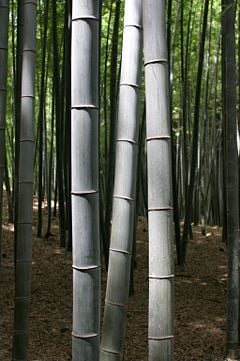 Bamboo forest in Kyoto, Japan
| ||||||||||||||||
| Scientific classification | ||||||||||||||||
| ||||||||||||||||
| Diversity | ||||||||||||||||
| Around 91 genera and 1,200 species | ||||||||||||||||
See the full Taxonomy of the Bambuseae. |
Bamboo comprises more than 1200 species of usually woody, perennial plants in the true grass family Poaceae, occurring primarily in tropical, subtropical, and temperate regions in Asia, Africa, and the Americas. Bamboo are distributed among more than 90 genera in the subfamily Bambusoideae and the tribe Bambuseae. The term also is used for the woody stems of these grasses, which have commercial value.
Unlike most grasses, bamboos can grow very tall, with some members reaching heights of up to 30 meters (98 feet).
In addition to its value to the ecosystem, providing food for giant pandas, insect larvae, gorillas, and elephants, bamboo is valued by humans for its culinary, medicinal, construction, artistic, and ornamental uses. The shoots of bamboo are used in numerous Asian dishes and broths; pickled bamboo is used as a condiment; and the sap of young stalks may be fermented to make a sweet wine or used to make a soft drink. Bamboo is used in Chinese medicine for treating infections and as a low calorie source of potassium. When properly processed and treated, bamboo forms a very hard, tough, and yet lightweight wood, useful in house construction, as well as for fences, bridges, furniture, and numerous other purposes, including the making of various musical instruments. The practice of carving bamboo for decorative artwork is widespread, and in China the fiber of bamboo has been used since early times for making paper. Bamboo is also popular as an ornamental plant.
Bamboo assumes symbolic meaning in East Asian culture, signifying such values as longevity and friendship, as representing the four seasons or a sacred barrier against evil. Bamboo represents eternity, tradition, and lineage, as noted in the Vietnamese proverb, "When the bamboo is old, the bamboo sprouts appear."
Description
Bamboo is a member of the grass family, Poaceae, which is one of the largest plant families, and to humans perhaps the most important, as this family includes agricultural grains such as wheat and rice, as well as sugar cane. The Poaceae comprise about 600 genera and perhaps ten thousand species of grasses, which include among them bamboo's more than 90 genera and more than 1200 species.
The tall species of bamboo are by far the largest members of the grass family, with the younger tips of some of those species growing more than 1 meter per day toward their ultimate height of more than 30 meters. As with all bamboo, the growth to maximum height and width is completed within one growing season. In subsequent years, the wood will harden and sprout more branchlets and leaves from the nodes in the stem, often starting at some distance up the culm (stalk) from the ground level.
Most bamboos are evergreen, but some have deciduous leaves.
The range encompassed by the many bamboo species extends from high mountains to low-lying tropical regions. Bamboo occur across East Asia, from 50°N latitude on Sakhalin Island in the Sea of Okhotsk, west to the Himalayas and Pakistan, and south as far as northern Australia.[1]. They also occur in sub-Saharan Africa, and in the Americas, where their range extends from the southeast of the U.S. to their most southerly limit at 47°S latitude in Chile.[2] Major areas with no native bamboos include Europe, north Africa, western Asia, Canada, most of Australia, and Antarctica.
Many bamboos grow as an understory in a forest whose canopy is formed by deciduous or coniferous trees (or both). The forests frequented by the giant panda in China, for example, are old growth forests with a canopy of both deciduous and coniferous trees, and an understory of bamboos, whose shallow root systems tend to occupy different soil terrain than the deep roots of the canopy trees.
Soft bamboo shoots, stems, and leaves are the major food source of the giant panda. Gorillas and elephants in parts of Africa forage on bamboo shoots when they are in season. Other animals that depend on the bamboo forests include the clouded leopard ranging from Nepal to southeastern China, the red panda on the forested slopes of the Himalaya Mountains, the ring-tailed lemur of Madagascar, cassowaries (large, flightless birds) found in Northeast Australia and New Guinea, and rhinoceros hornbill birds of Malaysia, Borneo, Sumatra, and Java.
Traditional uses
A western person who observed the many uses made of bamboo more than 100 years ago in China has recorded for posterity a glimpse of just how remarkably versatile bamboo is:
"Ode to Bamboo"
A man can sit in a bamboo house under a bamboo roof, on a bamboo chair at a bamboo table, with a bamboo hat on his head and bamboo sandals on his feet. He can at the same time hold in one hand a bamboo bowl, in the other hand bamboo chopsticks and eat bamboo sprouts. When through with his meal, which has been cooked over a bamboo fire, the table may be washed with a bamboo cloth, and he can fan himself with a bamboo fan, take a siesta on a bamboo bed, lying on a bamboo mat with his head resting on a bamboo pillow. His child might be lying in a bamboo cradle, playing with a bamboo toy. On rising he would smoke a bamboo pipe and taking a bamboo pen, write on bamboo paper, or carry his articles in bamboo baskets suspended from a bamboo pole, with a bamboo umbrella over his head. He might then take a walk over a bamboo suspension bridge, drink water from a bamboo ladle, and scrape himself with a bamboo scraper (handkerchief).[3]
Cuisine
The shoots of bamboo, new culms as they first emerge from the soil, are called in Chinese, zhú sǔn (simplified: 竹笋; traditional: 竹筍) or simply sǔn (笋). These are edible, used in numerous Asian dishes and broths, and are available in supermarkets in various sliced forms, either fresh or canned. Bamboo shoot tips are called zhú sǔn jiān (竹笋尖) or simply sǔn jiān (笋尖).
In Indonesia, the shoots are sliced thinly and then boiled with santan (thick coconut milk) and spices to make a dish named gulai rebung. Other recipes using bamboo shoots include sayur lodeh, a vegetable dish mixed in coconut milk, and lun pia (sometimes written lumpia), which is fried, wrapped bamboo shoots with vegetables. Note that the shoots of some species contain toxins that need to be leached or boiled out before they can be eaten safely.
Pickled bamboo, used as a condiment, may also be made from the pith of the young shoots.
The sap of young stalks tapped during the rainy season may be fermented to make a sweet wine, ulanzi, or simply made into a soft drink. Zhúyèqīng jiǔ (竹葉青酒) is a green-colored Baijiu Chinese liquor that has bamboo leaves as one of its ingredients.
Bamboo leaves also are used as wrappers for zongzi, a steamed dumpling typical of southern China that usually contains glutinous rice and other ingredients.
The empty hollow in the stalks of larger bamboo is used for cooking food in many Asian cultures. Soups are boiled and rice is cooked in the hollows of fresh stalks of bamboo directly over a flame. As well, steamed tea is sometimes rammed into bamboo hollows to produce compressed forms of Pu-erh tea.
In Sambalpur, India, the tender shoots are grated into julliens and fermented to prepare kardi. Also synonymous with bamboo shoots, the name is derived from the Sanskrit word for bamboo shoot, karira. This fermented bamboo shoot is used in various culinary preparations, notably amil, a sour vegetable soup. It is also made into pancakes using rice flour as a binding agent, along with spices and condiments to prepare a side dish in the local main meal. The shoots that have turned a little fibrous are fermented, dried, and ground to sand-size particles to prepare a garnish known as hendua.
Bamboo has gained increasing popularity in the culinary world as a material for cutting boards, as bamboo cutting boards are hard enough to withstand years of knife abuse, yet are more forgiving to the knife blade and cause less damage to the edged utensils over time than cutting boards made of other materials.
Medicine
Bamboo is used in Chinese medicine for treating infections. It is also a low calorie source of potassium. In Ayurveda, the Indian system of medicine, the siliceous concretion found in the culms of the bamboo is called banslochan. It is known as tabashir or tawashir in Unani-Tibb, the Indo-Persian system of medicine. This concretion, called in English, "bamboo manna," is said to be a tonic for respiratory diseases. This concretion, which was earlier obtained from the species Melocanna bambusoides, is very hard to get now and has been largely replaced by synthetic silicic acid. In most Indian literature, Bambusa arundinacea has been shown to be the source of bamboo manna.[4]
Construction
When treated, bamboo forms a very hard wood that is both light and exceptionally tough. In tropical climates, it is used in elements of house construction, as well as for fences, bridges, toilets, construction scaffolding, and as a substitute for steel reinforcing rods in concrete construction. When bamboo is harvested for wood, care is needed to select mature stems that are several years old, as first-year stems, although full size, are not fully woody and strengthened.
Artwork
Carving decorative bamboo artwork is a longstanding tradition in many cultures. The fiber of bamboo has been used for making paper in China since early times, and a high quality hand-made paper is still produced in small quantities. Coarse bamboo paper is still used to make Joss paper, or "spirit money," which is burned in traditional Chinese funerals and in ceremonies to deities or ancestors on traditional holidays.
Bamboo wood is used for making knitting needles, and bamboo fiber can be made into yarn and fabrics. Bamboo fabric is notable for its soft feel and natural antibacterial properties.[5] Clothing made from bamboo fiber is popular for activities such as yoga. Bed sheets and towels made from bamboo have become luxury items. Sharpened bamboo is also traditionally used for tattooing in Japan, Hawaii, and elsewhere.
Accessories
Bamboo canes are normally round in cross-section, but square canes can be produced by forcing the new, young culms to grow through a tube of square cross-section slightly smaller than the culm's natural diameter, thereby constricting the growth to the shape of the tube. Every few days the tube is removed and replaced higher up the fast-growing culm.
Bamboo also is used as a shank extension on smoking pipes. Often a bamboo shank is added as a repair when a shank is cracked with use, or to repair a flaw during manufacture.
A variety of bamboo was one of about two dozen plants carried by Polynesian voyagers to provide all their needs when settling new islands. In the Hawaiian Islands, among many uses, 'Ohe (bamboo) carried water, made irrigation troughs for taro terraces, was used as a traditional knife for cutting the umbilical cord of a newborn, as a stamp for dyeing bark tapa cloth, and for four hula instruments—nose flute, rattle, stamping pipes, and Jew's harp.
Recreation

Some skateboard and snowboard deck manufacturers, as well as surfboard builders, are beginning to use bamboo construction because bamboo can be both lighter and stronger than traditional materials and its cultivation is environmentally friendly.
Bamboo is used also for making enclosures in fish farming, where cages can be made from a wooden frame and bamboo lattices. Bamboo is also used in the making of the high-end, lightweight fishing rods used in fly fishing.
Musical instruments
Bamboo is used in making various musical instruments, such as the dizi, xiao, shakuhachi, palendag, jinghu, and angklung. The Bamboo Organ of Las Pinas, Philippines, has pipes made of bamboo culms.
In Indonesia, bamboo has been used for making various kinds of musical instruments, the most popular ones being kolintang and angklung. Especially for angklung, it is the pride and joy of the Sundanese people, and they have been safeguarding this tradition for centuries. Although, it is (to a lesser extent) also played by the Balinese, and later on spread to the neighboring countries in south east Asia.
A single shoot of bamboo can also be made into a didgeridoo, a wind instrument indigenous to Australia.
Cultivation
Many bamboos are popular in cultivation as garden plants, although care needs to be taken lest they take over the garden through their invasive behavior. They spread mainly through their roots and/or rhizomes, which can spread widely underground and send off new culms to break through the surface.
There are two patterns for the spreading of bamboo, "clumping" (sympodial), and "running" (monopodial). Clumping bamboo species tend to spread underground slowly. Bamboos are highly variable in their tendency to spread; this is related to both the species and the soil and climate conditions. Some can send out runners several meters in a year, while others can stay in the same general area for long periods.
Once a grove of bamboo is established, it may not be possible to completely remove it without digging up the entire network of underground rhizomes. If bamboo must be removed, an alternative to digging it up is to cut down the culms, and then repeatedly mow down new shoots as they arise, until the root system exhausts its energy supply and dies. If any leaves are allowed to photosynthesize, the bamboo survives and will keep spreading.
There are two main ways to prevent the spread of running bamboo into adjacent areas. The first method is rhizome pruning or "edging," which involves removing any rhizomes escaping the desired bamboo area. Hooks, shovels, and picks are usual tools. The rhizomes are generally very close to the surface (just under a sod layer), so, if rhizome pruning is done twice a year, it will sever most, if not all, of the new growth. Some species may be deep running (beyond typical spade depth). These are much harder to control and deeper cuts will need to be made. Regular maintenance will indicate major growth directions and locations. Once the rhizomes are cut, they should be removed. If any bamboo shoots come up outside of the bamboo area afterwards, their presence indicates the precise location of the missed rhizome. The fibrous roots that radiate from the rhizomes do not grow up to be more bamboo, so they stay in the ground.
The second way is by surrounding the bamboo root mass with a physical barrier. Concrete and specially rolled HDPE plastic are usual materials. This is placed in a 60-90 cm (2-3 feet) deep ditch around the planting, and angled out at the top to direct the rhizomes to the surface. Strong rhizomes and tools can penetrate plastic barriers with relative ease, so great care must be taken. Bamboo entangled in barriers is much more difficult to remove than free-spreading bamboo. Barriers and edging are unnecessary for clump forming bamboos, although even they may eventually need to have portions taken out if they get too large.
Bamboo in human culture
Symbolism
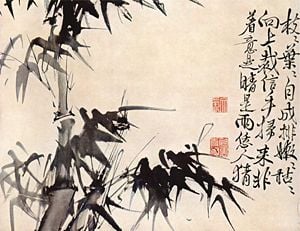
In Chinese culture, the bamboo (zhú 竹), plum blossom (méi 梅), orchid (lán 蘭), and chrysanthemum (jú 菊) (usually, méi lán zhú jú 梅蘭竹菊) are collectively referred to as the Four Noble Ones (四君子). These four plants also represent the four seasons and, in Confucian ideology, four aspects of the junzi (君子 "prince" or "noble one"). The pine tree (松), the bamboo, and the plum blossom (sōng zhú méi 松竹梅) are also admired for their perseverance under harsh conditions, and are together known as the "Three Friends in Winter" (歲寒三友).
Bamboo's long life makes it a Chinese symbol of longevity, while in India it remains a symbol of friendship. The rarity of its blossoming has led to the flowers' being regarded as a sign of impending famine. This may be due to rats feeding upon the profusion of flowers, then multiplying and destroying a large part of the local food supply. The most recent flowering began in May 2006. Bamboo is said to bloom in this manner only about every 50 years.[6]
In Japan, a bamboo forest sometimes surrounds a Shinto shrine as part of a sacred barrier against evil. Also, bamboo (také 竹) indicates something of the second rank, as a sushi set or accommodations at a traditional Ryokan inn. This comes from the Chinese phrase 松竹梅 (in Japanese, sho-chiku-bai), where pine (matsu 松) is of the first rank, and plum (ume 梅) is of the third.
A Vietnamese proverb says: "When the bamboo is old, the bamboo sprouts appear," the meaning being Vietnam will never be annihilated; if the previous generation dies, the children takes its place. Therefore the Vietnamese tradition will be maintained and developed eternally.
Myths and legends
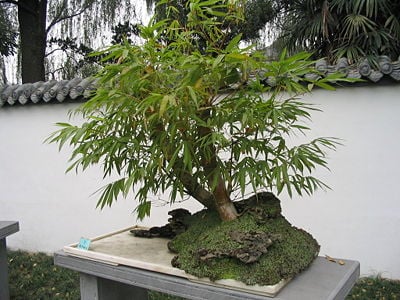
Several Asian cultures, including that of the Andaman Islands, believe that humanity emerged from a bamboo stem. In the Philippine creation myth, the first man and the first woman came forth from a special bamboo stem that grew on an island created after the battle of the elemental forces (Sky and Ocean). In Malaysian legends, a similar story includes a man who dreams of a beautiful woman while sleeping under a bamboo plant; he wakes up and breaks the bamboo stem, discovering the woman inside. The Japanese folktale "Tale of the Bamboo Cutter" (Taketori Monogatari), tells of a princess from the Moon emerging from a shining bamboo section. Hawaiian bamboo ('ohe) is a kinolau, or body form of the Polynesian creator god Kāne Milohai.
An ancient Vietnamese legend tells of a poor, young farmer who fell in love with his landlord's beautiful daughter. The farmer asked the landlord for his daughter's hand in marriage, but the proud landlord would not allow her to be bound in marriage to a poor farmer. The landlord decided to foil the marriage with an impossible deal; the farmer must bring him a "bamboo tree of one-hundred sections." The benevolent god Bụt appeared to the farmer and told him that such a tree could be made from one-hundred sections from several different trees. Bụt gave to him four magic words to attach the many sections of bamboo: "Khắc nhập, khắc xuất," which means "put in immediately, take out immediately." The triumphant farmer returned to the landlord and demanded his daughter. The story ends with the happy marriage of the farmer and the landlord's daughter.
Science
The Song Dynasty (960-1279 C.E.) Chinese scientist and polymath, Shen Kuo (1031-1095), used the evidence of underground petrified bamboo found in the dry northern climate of Yan'an, Shanbei region, Shaanxi province to support his geological theory of gradual climate change.[7]
Innovative uses
With perhaps a billion people in the developing world dependent on bamboo in one way or another, bamboo has often in the twentieth century been associated with poverty. That old image is being displaced in the twenty-first century by the new image of a versatile plant offering essential survival values for even the most advanced countries, as all are increasingly forced to grapple with the issue of environmental sustainability. Here, bamboo is in a class by itself.
Bamboo offers unique economic and ecological values as a commercially grown source of wood products adaptable to a multitude of construction uses and competitive with conventional hardwood and softwood construction materials in terms of price and performance. As a woody, perennial grass, bamboo offers strong environmental values that cannot be matched by hardwood and softwood products because bamboo can be harvested as a mature plant on a cycle varying from 3-7 years, while leaving in the ground the root system that can grow a new crop over another 3-7 years. The dense root system holds the soil in place even after the crop is harvested and the relatively light weight of a mature bamboo stalk in comparison to timber means that the bamboo harvesting equipment can be less disruptive of the ground surface than timber harvesting equipment.
The South American country of Colombia became a global-level center of innovation of bamboo construction after the 2000 World Expo in Hannover, Germany, where the most-visited pavilion was a large bamboo structure designed and fabricated in Colombia. Several German academic institutions collaborated in testing the pavilion's construction quality and in the end certified it as being fully safe and sound. The pavilion received more than 6 million visitors during the 5 month Expo. It was subsequently disassembled and then reassembled and permanently mounted back in Manizales, Colombia, in the heart of the country's coffee growing area, which was the area responsible for originally funding the building as part of a larger effort toward sustainability inspired by the Zero Emissions Research and Initiatives (ZERI). The architect, Simon Velez, has become a leader in a global movement to establish bamboo as primary construction material throughout the world. People have gone to Colombia to study with him then take their new knowledge and expertise in building with bamboo back to their home country.
Modern companies are attempting to popularize bamboo flooring made of bamboo pieces steamed, flattened, glued together, finished, and cut, and the effort is succeeding in the U.S. and Europe. National and state level bamboo associations are proliferating and affiliating under the umbrella of the World Bamboo Organization, which declares its mission to be that of promoting and supporting the use of bamboo as a sustainable and alternative natural resource. Interests of the organization's members range from growing bamboo in gardens to growing it as a commercial product, processing it into an effective construction material, building bamboo homes and buildings, and as well living in a bamboo house. The first decade of the twenty-first century has been a period for bamboo to pass through all the tests for gaining international building code certification for use in the manufacture of such products as chipboard, plywood, I-Beams, and other bamboo structural materials. A factory in Vietnam was the first to gain international building code certification for its full range of building products, while the first company in the U.S. offering building code approved bamboo homes was based in Hawaii.
Taxonomy of Bambuseae
The Bambuseae comprises around 1,200 species, distributed into numerous tribes, subtribes, and about 91 genera:
Subtribe Arthrostylidiinae
It comprises 12 genera:
- Actinocladum
- Alvimia
- Arthrostylidium
- Athroostachys
- Atractantha
- Aulonemia (Matudacalamus)
- Colanthelia
- Elytrostachys
- Glaziophyton
- Merostachys
- Myriocladus
- Rhipidocladum
Subtribe Arundinariinae
It comprises 17 genera:
- Acidosasa
- Ampelocalamus
- Arundinaria
- Borinda
- Chimonocalamus (Sinarundinaria)
- Drepanostachyum
- Fargesia
- Ferrocalamus
- Gaoligongshania
- Gelidocalamus
- Himalayacalamus
- Indocalamus
- Oligostachyum
- Pseudosasa
- Sasa
- Thamnocalamus
- Yushania
Subtribe Bambusinae
It comprises 10 genera:
- Bambusa (Dendrocalamopsis)
- Bonia (Monocladus)
- Dendrocalamus (Klemachloa, Oreobambos, Oxynanthera, Sinocalamus)
- Gigantochloa
- Dinochloa
- Holttumochloa
- Kinabaluchloa (Maclurochloa, Soejatmia)
- Melocalamus
- Sphaerobambos
- Thyrsostachys
Subtribe Chusqueinae
It comprises 2 genera:
- Chusquea (Dendragrostis, Rettbergia)
- Neurolepis (Planotia)
Subtribe Guaduinae
It comprises 5 recognized genera:
- Apoclada
- Eremocaulon (Criciuma)
- Guadua
- Olmeca
- Otatea
Subtribe Melocanninae
It comprises 9 genera:
- Cephalostachyum
- Davidsea
- Leptocanna
- Melocanna (Beesha)
- Neohouzeaua
- Ochlandra
- Pseudostachyum
- Schizostachyum
- Teinostachyum
Subtribe Nastinae
It comprises 6 genera:
- Decaryochloa
- Greslania
- Hickelia
- Hitchcockella
- Nastus
- Perrierbambus
Subtribe Racemobambodinae
It comprises 1 genus:
- Racemobambos (Neomicrocalamus, Vietnamosasa)
Subtribe Shibataeinae
It comprises 9 genera:
- Brachystachyum
- Chimonobambusa
- Indosasa
- Phyllostachys
- Qiongzhuea
- Semiarundinaria
- Shibataea
- Sinobambusa
- Temburongia (incertae sedis)
Notes
ReferencesISBN links support NWE through referral fees
- Bystriakova, N., V. Kapos, I. Lysenko, and C. M. A. Stapleton. Distribution and conservation status of forest bamboo biodiversity in the Asia-Pacific Region. Biodiversity and Conservation 12(9) (2003): 1833-1841. Retrieved June 26, 2019.
- Huberman, M. A. Bamboo silviculture. Unasylva 13(1) (1959). Retrieved June 26, 2019.
- International Bamboo Building Design Competition. 2007. Competition Sponsors, Partners and Affiliated Organizations Retrieved June 26, 2019.
- International Conference on the History of Science in East Asia (ICHSEA), A. K.-L. Chan, G. K. Clancey, and H.-C. Loy. Historical Perspectives on East Asian Science, Technology, and Medicine. Singapore: World Scientific, 2003. ISBN 9971692597
- Lela Designs. Fabric facts and questions. Lela Designs, 2007.
- Needham, J., P. Y. Ho, G.-D. Lu, and L. Wang. Science and Civilization in China. Volume 3: Mathematics and the Sciences of the Heavens and the Earth. Taipei: Caves Books, 1986.
- Puri, H. S. 2003. Rasayana Ayurvedic Herbs for Longevity and Rejuvenation. London: Taylor & Francis. ISBN 0415284899
- World Bamboo Organization. World Bamboo 2007. Retrieved June 26, 2019.
Credits
New World Encyclopedia writers and editors rewrote and completed the Wikipedia article in accordance with New World Encyclopedia standards. This article abides by terms of the Creative Commons CC-by-sa 3.0 License (CC-by-sa), which may be used and disseminated with proper attribution. Credit is due under the terms of this license that can reference both the New World Encyclopedia contributors and the selfless volunteer contributors of the Wikimedia Foundation. To cite this article click here for a list of acceptable citing formats.The history of earlier contributions by wikipedians is accessible to researchers here:
The history of this article since it was imported to New World Encyclopedia:
Note: Some restrictions may apply to use of individual images which are separately licensed.
